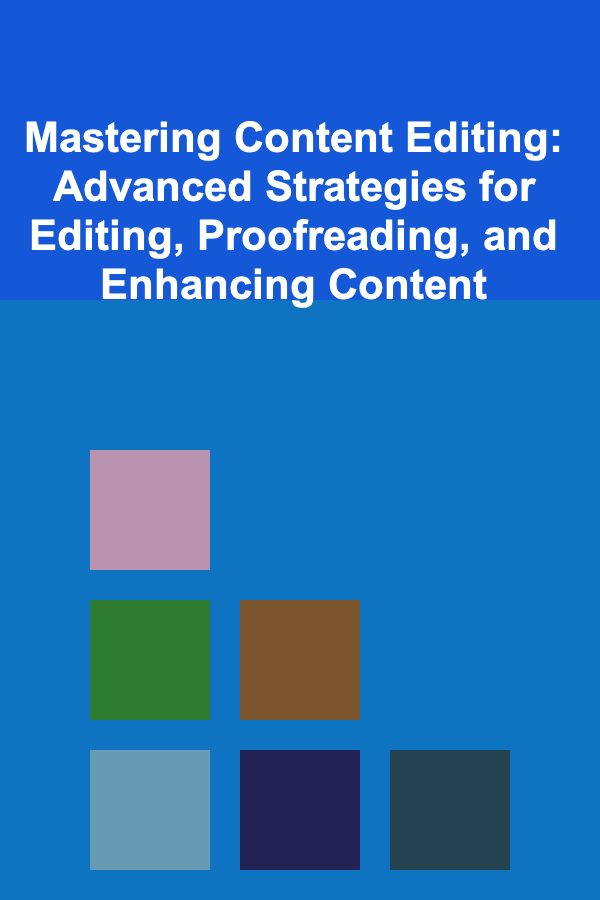
Mastering Content Editing: Advanced Strategies for Editing, Proofreading, and Enhancing Content
ebook include PDF & Audio bundle (Micro Guide)
$12.99$11.99
Limited Time Offer! Order within the next:

Content editing is a critical part of the writing process that goes beyond simple grammar and spelling corrections. It involves a deep understanding of language, structure, tone, and clarity to transform a raw draft into a polished, effective piece of content. Whether you're editing for a blog, article, marketing copy, or academic paper, mastering content editing requires advanced strategies and a keen eye for detail. This actionable guide dives into the most effective techniques for refining, proofreading, and enhancing written content to ensure it communicates its message clearly and powerfully.
Understand the Content's Purpose and Audience
Before you even begin editing, it's crucial to understand the content's purpose and its target audience. Every piece of writing is created with a specific goal in mind, whether it's to inform, entertain, or persuade. Knowing the purpose allows you to edit with intention, ensuring that the content aligns with its original objective.
Clarify the Primary Objective
Ask yourself:
- What is the main message the writer is trying to convey?
- How will this content impact or influence the reader?
- Is the writing tailored to a specific stage in the reader's journey (e.g., awareness, consideration, decision)?
Audience-Centric Editing
Different audiences respond to different tones, language, and structures. Whether the audience is a technical expert or a casual reader, adjusting the content to meet their expectations and knowledge level is essential. For example, a blog post aimed at a general audience should use simple language and clear explanations, while an academic paper might incorporate complex terminology and data.
Refining Clarity and Coherence
Clarity is at the heart of good content. Without clarity, even the most well-intended message can be misunderstood. Editing for clarity involves simplifying complex ideas, ensuring logical flow, and avoiding unnecessary jargon.
Simplify Complex Ideas
Content that is convoluted or overly technical can confuse the reader. Simplify ideas by breaking down long sentences into smaller, more digestible parts. Use straightforward language without oversimplifying the content.
Example:
- Before: "The implementation of the newly designed strategies, which are expected to yield significant results in the upcoming quarter, has been slated for immediate rollout."
- After: "The new strategies will be rolled out soon, aiming to deliver significant results in the next quarter."
Eliminate Ambiguity
When editing, ensure that each sentence has a clear and precise meaning. Vague language or ambiguous phrasing can undermine the content's effectiveness. Replace vague terms with specific language that leaves little room for interpretation.
Example:
- Before: "We will try to improve productivity in the near future."
- After: "We will increase productivity by 20% within the next six months."
Maintain Logical Flow
Content must flow logically from one section to the next. Ensure that each paragraph and idea is connected, leading the reader seamlessly through the material. Look for opportunities to improve transitions and guide the reader naturally from one point to the next.
Example:
- Before: "The company faced challenges in meeting deadlines. However, it also invested in new software that greatly improved workflow."
- After: "To address challenges in meeting deadlines, the company invested in new software, which greatly improved workflow."
Structuring Content for Maximum Impact
The structure of content plays a key role in how easily it can be consumed and understood. A well-structured piece keeps the reader engaged and ensures that the key messages stand out.
Focus on Paragraphs and Sections
Long blocks of text can be overwhelming. Break up content into manageable paragraphs and sections with clear headings. Each section should focus on one main idea, with supporting information that flows logically.
Example:
- Before: "The team worked long hours to improve the project. Despite the challenges, the results were quite impressive, and everyone contributed to the success of the project."
- After : Challenges : "The team faced significant challenges, working long hours to stay on track." Results: "Despite these challenges, the results were impressive, and the entire team contributed to the project's success."
Use Clear and Informative Headings
Headings and subheadings guide readers through the content, making it easier to digest. Each heading should clearly indicate the topic of the section it precedes. Avoid overly vague or abstract headings; instead, use specific titles that set clear expectations.
Example:
- Before: "Working with Us"
- After: "How Our Collaborative Approach Drives Successful Outcomes"
Create Strong Introductions and Conclusions
The introduction sets the stage for the content, while the conclusion ties everything together. Ensure the introduction grabs the reader's attention and provides context for the content. The conclusion should summarize the key points and, when appropriate, include a call to action.
Example:
- Before: "In conclusion, our team has worked hard."
- After: "In conclusion, our team's dedication and collaboration have driven significant improvements in our workflow. Moving forward, we are poised to tackle even greater challenges."
Enhancing the Style and Tone
The style and tone of the content reflect the brand's voice and can significantly impact how the audience perceives the message. Effective editing ensures that the content maintains the right balance of formal and informal language, depending on the context.
Maintain Consistent Tone
Consistency in tone is vital, whether it's friendly, professional, conversational, or authoritative. As an editor, ensure that the tone remains uniform throughout the piece. Shifting tones can confuse the reader and dilute the message.
Example:
- Before: "This software is the best for professionals. You might want to try it out."
- After: "This software is the top choice for professionals seeking efficiency and reliability."
Avoid Overly Complex or Wordy Language
While using sophisticated language is appropriate in certain contexts, it can make content difficult to follow if used excessively. Aim to strike a balance between professional language and accessibility. Avoid using too many adjectives, adverbs, or complex sentence structures unless necessary.
Example:
- Before: "We are tremendously proud of the remarkable results that have been brought to fruition as a result of our remarkable efforts."
- After: "We are proud of the excellent results achieved through our efforts."
Ensure Proper Punctuation and Grammar
Advanced grammar and punctuation rules help maintain clarity and professionalism. Pay attention to punctuation marks, such as commas, semicolons, and apostrophes, ensuring that they are used correctly throughout the content.
Common Areas to Focus On:
- Comma splices (joining two independent clauses with just a comma)
- Misplaced apostrophes (e.g., "its" vs. "it's")
- Incorrect use of semicolons
Advanced Proofreading Techniques
Proofreading is the final step in the editing process, focusing on identifying errors in spelling, grammar, punctuation, and consistency. Advanced proofreading involves more than just spotting mistakes---it's about ensuring that the content is polished and ready for publication.
Read Aloud
Reading the content aloud is a powerful proofreading technique. It helps you catch awkward phrasing, run-on sentences, or sections that feel disjointed. This step also helps you hear how the content flows, ensuring it sounds natural and engaging.
Take Breaks Between Drafts
After editing a draft, take a short break before proofreading. Returning to the content with fresh eyes allows you to spot errors or inconsistencies you might have missed in the initial review.
Proofread in Layers
Instead of proofreading for everything at once, focus on one element at a time. First, check for spelling and grammar errors, then move on to punctuation. Once that's done, focus on sentence structure and clarity. This layered approach ensures that nothing is overlooked.
Use Technology, But Don't Rely on It
While tools like Grammarly or Hemingway can catch some common errors, they shouldn't be relied upon exclusively. These tools often miss contextual mistakes or provide suggestions that don't align with the style or tone you're aiming for. Always use your judgment and intuition as an editor.
Final Enhancements and Refinements
Once you've addressed the structural, stylistic, and grammatical elements, it's time to polish the content and add those final touches that elevate it from good to great.
Strengthen the Opening and Hook
The first few lines of content are crucial for capturing the reader's attention. If the introduction is weak or uninspiring, readers may lose interest before they've even gotten to the main content. Refine the opening so that it draws the reader in immediately.
Example:
- Before: "This article will discuss how to improve your writing skills."
- After: "Want to take your writing to the next level? This article will show you how to transform your writing from average to exceptional."
Use Vivid and Engaging Language
Incorporate evocative language where appropriate to make the content more compelling. Use strong verbs, vivid adjectives, and concrete imagery to make the writing more dynamic and engaging.
Example:
- Before: "The company had a good year."
- After: "The company experienced a banner year, surpassing expectations and setting new records."
Ensure Visual Appeal
In digital content, formatting and presentation are just as important as the writing itself. Ensure that the content is well-formatted, with appropriate use of white space, bold text for emphasis, and consistent fonts. This enhances readability and makes the content more visually appealing.
Conclusion
Mastering content editing requires a combination of technical skills, a deep understanding of the content's purpose, and a dedication to refinement. By applying advanced strategies for editing, proofreading, and enhancing content, you can take your writing to new heights, ensuring that it communicates clearly, engages the reader, and fulfills its intended goal. Whether you're editing a blog post, marketing copy, or an academic article, the techniques outlined in this guide will help you create polished, effective, and impactful content every time.

How to Create a Diversified Investment Portfolio Using ETFs
Read More
How to Create a Relaxing Atmosphere for a Stress-Free Party
Read More
How to Integrate Dropshipping Suppliers with Your Ecommerce Platform
Read More
How to Integrate Smart Home Devices for Convenience
Read More
How to Involve Local Businesses in Supporting Your Reunion
Read More
What Tips Can Help You Create a Functional Guest Room?
Read MoreOther Products

How to Create a Diversified Investment Portfolio Using ETFs
Read More
How to Create a Relaxing Atmosphere for a Stress-Free Party
Read More
How to Integrate Dropshipping Suppliers with Your Ecommerce Platform
Read More
How to Integrate Smart Home Devices for Convenience
Read More
How to Involve Local Businesses in Supporting Your Reunion
Read More